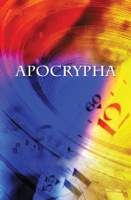Apocrypha
Origin
Medieval Latin, from Late Latin, neuter plural of apocryphus secret, not canonical, from Greek apokryphos obscure, from apokryptein to hide away, from apo- + kryptein to hide
Definitions
- 1: writings or statements of dubious authenticity
- 2capitalized. a : books included in the Septuagint and Vulgate but excluded from the Jewish and Protestant canons of the Old Testament
b : early Christian writings not included in the New Testament
Description
Apocrypha are statements or claims that are of dubious authenticity. The word's origin is the medieval Latin adjective apocryphus, "secret, or non-canonical", from the Greek adjective ἀπόκρυφος (apocryphos), "obscure", from verb ἀποκρύπτειν (apocryptein), "to hide away".
It is commonly applied in Christian religious contexts involving certain disagreements about biblical canonicity. The pre-Christian-era Jewish translation (into Greek) of holy scriptures known as the Septuagint included the writings in dispute. However, the Jewish canon was not finalized until at least 100–200 years into the A.D., at which time considerations of Greek language and beginnings of Christian acceptance of the Septuagint weighed against some of the texts. Some were not accepted by the Jews as part of the Hebrew Bible canon. Over several centuries of consideration, the books of the Septuagint were finally accepted into the Christian Old Testament, by A.D. 405 in the west, and by the end of the fifth century in the east. The Christian canon thus established was retained for over 1,000 years, even after the 11th-century schism that separated the church into the branches known as the Roman Catholic and Eastern Orthodox churches.
Those canons were not challenged until the Protestant Reformation (16th century), when both the Roman Catholic and Eastern Orthodox Churches reaffirmed them. The reformers rejected the parts of the canon that were not part of the Hebrew Bible and established a revised Protestant canon. Thus, concerning the Old Testament books, what is thought of as the "Protestant canon" is actually the final Hebrew canon. The differences can be found by looking here or by comparing the contents of the "Protestant" and Catholic Bibles, and they represent the narrowest Christian application of the term Apocrypha.
Among some Protestants, apocryphal began to take on extra or altered connotations: not just of dubious authenticity, but having spurious or false content, not just obscure but having hidden or suspect motives. Protestants were (and are) not unanimous in adopting those meanings. The Church of England agreed, and that view continues today throughout the Lutheran Church, the worldwide Anglican Communion, and many other denominations. Whichever implied meaning is intended, Apocrypha was (and is) used primarily by Protestants, in reference to the books of questioned canonicity. Catholics and Orthodox sometimes avoid using the term in contexts where it might be considered disputatious or be misconstrued as yielding on the point of canonicity. Very few Protestant published Bibles include the apocryphal books in a separate section (rather like an appendix), so as not to intermingle them with their canonical books.
Explaining the Eastern Orthodox Church's canon is made difficult because of differences of perspective with the Roman Catholic church in the interpretation of how it was done. Those differences (in matters of jurisdictional authority) were contributing factors in the separation of the Roman Catholics and Orthodox around 1054, but the formation of the canon was largely complete (fully complete in the Catholic view) by the fifth century, six centuries before the separation. In the eastern part of the church, it took much of the fifth century also to come to agreement, but in the end it was accomplished. The canonical books thus established by the undivided church became canon for what was later to become Roman Catholic and Eastern Orthodox alike. The East did already differ from the West in not considering every question of canon yet settled, and it subsequently adopted a few more books into its Old Testament. It also allowed consideration of yet a few more to continue not fully decided, which led in some cases to adoption in one or more jurisdictions, but not all. Thus, there are today a few remaining differences of canon among Orthodox, and all Orthodox accept a few more books than appear in the Catholic canon. Protestants accept none of these additional books as canon either, but see them having roughly the same status as the earlier Apocrypha. As Protestant awareness of the Eastern Orthodox increases in nations like the United States, interest in the full Orthodox canon might also increase enough for them to be published in the Apocrypha of some Protestant Bibles. That is not common yet in 2013, so they are not as widely available in English.
Before the fifth century, the Christian writings that were then under discussion for inclusion in the canon but had not yet been accepted were classified in a group known as the ancient antilegomenae. These were all candidates for the New Testament and included several books which were eventually accepted, such as: The Epistle to the Hebrews, 2 Peter, 3 John and the Revelation of John (Apocalypse). None of those accepted books can be considered Apocryphal now, since all Christendom accepts them as canonical. Of the uncanonized ones, the Early Church considered some heretical but viewed others quite well. Some Christians, in an extension of the meaning, might also consider the non-heretical books to be "apocryphal" along the manner of Martin Luther: not canon, but useful to read. This category includes books such as the Epistle of Barnabas, the Didache, and The Shepherd of Hermas which are sometimes referred to as the Apostolic Fathers.[1]
